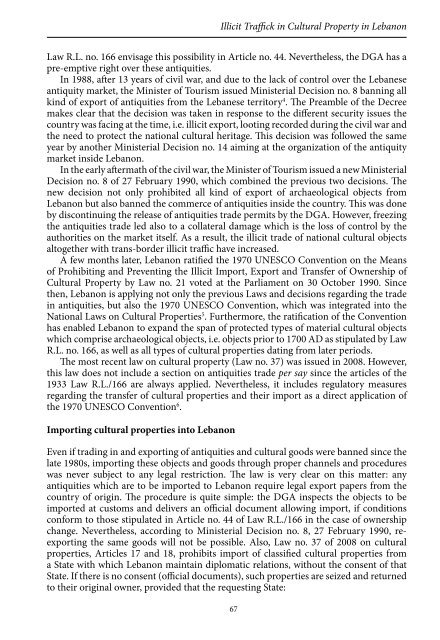Countering
Book_observatory_illicit_traffic_version%20issuu
Book_observatory_illicit_traffic_version%20issuu
You also want an ePaper? Increase the reach of your titles
YUMPU automatically turns print PDFs into web optimized ePapers that Google loves.
Assad Seif<br />
• pay just compensation to an innocent purchaser or to the lawful owner,<br />
• provide, at its expense, evidence and relevant documents supporting its request<br />
for recovery and return,<br />
• bear all costs related to the return of cultural goods (freight, insurance and<br />
delivery).<br />
Clandestine excavations and illicit traffick during the Lebanese civil war 1975 - 1990<br />
During the Lebanese civil war, clandestine excavations and illicit traffick in archaeological<br />
objects spread due to the absence of general government control. This situation reached<br />
dramatic proportions in second half of the 1980s (Hakimian 1989). During this decade,<br />
clandestine digging spread to the most remote areas of the country (Seeden 1990: 142).<br />
The areas that underwent most of the clandestine activities during the civil war were The<br />
Beqaa, namely Baalbek and western Beqaa, and the South (Fadlallah 1992: 75).<br />
People in the villages, especially those located nearby ongoing excavations, took<br />
advantage of the lack of government control and began illicit excavations on archeological<br />
site premises. Little by little, the excavations invaded the archaeological sites, which were<br />
pilfered using heavy machinery, inter alia excavators and bulldozers. This was the case<br />
of Kamid el Loz (ancient Kumidi) in western Beqaa, where archaeological excavations<br />
stopped prematurely in 1981 (Seeden 1991: 3-4).<br />
Uncontrolled and unorganized constructions during the war also lead to archaeological<br />
discoveries that attracted clandestine excavators. Wherever a new construction site was<br />
initiated, especially in areas known to have potential archeological value, clandestine<br />
diggers would inspect the excavation for any potential hole in the ground that could lead<br />
to a tomb, or any structure that could reveal the presence of artifacts, especially mosaic<br />
floors, very prized by the collectors (Fadlallah 1992: 76). Once someone finds a tomb in<br />
a new area, frantic looters would sense its presence kilometers away. The next day, the<br />
entire area would be pitted and cratered by looters searching for other tombs and new<br />
material to be sold to the dealers.<br />
The major sites affected by looting are burial sites from the Phoenician and classical<br />
periods. These tombs much prized for their valuable artefacts, which were often well<br />
preserved. This means good prices upon sale. Also, early Christian and Byzantine<br />
churches and basilicas were tracked for their important and valuable mosaic floors.<br />
Clandestine excavations were not limited to the land, many were done underwater<br />
nearby historic cities known to have been major habour cities during the Antiquity. The<br />
most looted maritme area is situated in front of Tyre’s shore in southern Lebanon, where<br />
thousands of statues and amphorae were dug out from shipwrecks lying beneath the<br />
sea waters. Statues illegally extracted from the waters of Tyre are still on sale in fancy<br />
antiquarian boutiques in the UAE today.<br />
Once extracted from clandestine excavations, looted artefacts would be collected by<br />
smugglers and dealers who pass them through borders in order to reach international<br />
markets, where they sell for tenfold the price alloted to diggers. The dealers have strong<br />
local and international connections, which eases their work and ensures the quick<br />
liquidation of their goods. Some of the dealers even opened their own antiquarian<br />
boutiques in many western countries, namely Geneva and New York. In this context,<br />
many cultural objects were destroyed due to improper methods used in clandestine<br />
digging. The remaining objects were exported out of the country. And along with it<br />
68


